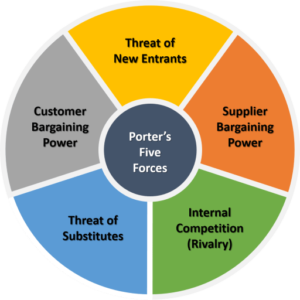Introduction and Company
- Organisational strategy is the whole activities and actions of an organisation to reach with desired goals and objectives.
- It helps in developing and making a company to achieve their targets by determining the corporate culture.
- It enables an organisation to distribute required resources to address the priorities.
- Tata Motors is an international automobile manufacturing company.
- There are various products of an organisation which includes passengers, cars, sports cars, construction equipments and so more.
- It is the biggest automobile company which provide variety of products to their customers.
Organisational Strategy
- Tata motors develops strategy to increase the capacity of company by developing trust and loyalty among all staff members.
- It also helps in developing its strategy to capture whole market place. The main motive of this company is to satisfying and fulfilling customers needs and requirements.

Porter’s five forces
PESTLE:
| PESTLE |
| Political: It affects the company performance. |
| Economic: This factor analyse the economic condition and it affects on business growth. |
| Social: It helps in evaluate customers needs and wants. |
| Technological: New methods and equipments assist in increasing profits. |
| Legal: Laws and regulations affects the business environment. |
| Environmental: Need to use only friendly products and services. |
SWOT Analysis:
| Strength | Weakness |
| •Strong parent base
•Brand equity •Global presence •Provides variety of equipments and cars |
•Poor technical base
•Lack of uniqueness and creativity |
| Opportunities | Threats |
| •Huge investment
•Expand business operations in different areas |
•Intense competition
•Increasing in income and profitability |
MC Kinsey 7S
- Strategic model allows an organization to deal with competitive market place.
- MC Kinsey model involves seven elements that help company in achieving goals.
- There are 7 elements that are divided into soft and hard components as under:
| Hard Elements | Soft Elements |
| Strategy | Shared Values |
| Structure | Skills |
| System | Style |
| Staff |
VMOST
- Vision: Provide best cars at reasonable rate.
- Mission: Tata Motors focus on offering standard and high tech cars.
- Objectives: Offers best technological and unique cars to customers.
- Strategy: Focus on competitive pricing tactics.
- Tactics: Limited range with price change policy.
Value chain
| Manufactures | Distribution | Store sales | Marketing |
| •Local suppliers
•National suppliers •Global level suppliers |
•Use accurate channel for distribution
•Distribution centers |
•Tata motors established in different areas
•Well trained employees to sales |
•Social media
•Develop relationship with customers •Websites |
SFA ANALYSIS
Suitability, feasibility and acceptability of Tata Motors is describe as follow:
| Option 1
Market development (Asian) |
Option 2
New range of product |
Option 3
New area for expansion |
|
| Suitability | 6 | 6 | 6 |
| Feasibility | 7 | 7 | 5 |
| Acceptability | 7 | 6 | 5 |
| Total | 20 | 19 | 16 |
FIMO ANALYSIS
| Hyundai Motors | Tesla | Audi | |||||||
| 2019 | 2018 | 2017 | 2019 | 2018 | 2017 | 2019 | 2018 | 2017 | |
| Total Revenue | 4000 | 4055 | 3300 | 7000 | 4000 | 3340 | 25454 | 23434 | 234 |
| Cost of sales | 1343 | 1565 | 1654 | 6000 | 3450 | 2900 | 15656 | 16767 | 14545 |
| Gross Profit | 2657 | 2401 | 1646 | 1000 | 550 | 440 | 9798 | 6667 | 14311 |
| Net Income | 450 | 480 | 1123 | 1345 | 765 | 3342 | 2434 | 1565 | 1232 |
Risk Assessment
The risk assessment of Tata Motors propose as follow:
| Recommendation | Risk level | Likelihood | Rating | Project Impact |
| Enter into Asian market | 3: Moderate risk level | Less likely as automobile market growth can be increase. | 5: Need high cost and financial stability | 4: Less impact due to low cost |
| New range of product | 4: High risk | Likely due to original capability | 6: Require huge investment on R&D | 4: Less impact |
Recommendation
- It can be recommended that Tata Motors should develop mission and decision making which is taken on allocating resources in entire company.
- Tata motors leaders determines and evaluate the way of growth that should be taken to increase the business operations.
- Tata motors goals is to provide variety of products and services to desired clients.
Reflection
- Tata Motors focus on taking higher position in the large market place.
- The company is competing with other local automobiles as it also provides great quality of goods and services at reasonable rate.
- An organisation focus on maintaining and increasing success level of the firm.
Conclusion
- Tata Motors is successful in the automobile sector with the helps of using cost saving policy and strategy.
- The company maintaining business operations and develop effective strategy to achieve higher goals.
- It assist in managing whole business and attract large number of customers.
References
Williams, D.J., Faiz, M.A., Abela-Ridder, B., Ainsworth, S., Bulfone, T.C., Nickerson, A.D., Habib, A.G., Junghanss, T., Fan, H.W., Turner, M. and Harrison, R.A., 2019. Strategy for a globally coordinated response to a priority neglected tropical disease: Snakebite envenoming. PLoS neglected tropical diseases, 13(2), p.e0007059.
Vinod, V., 2020. A study on Human Resource’s Business Partner Strategy within the Organisation (Doctoral dissertation, Savitribai Phule Pune University).
Candido, C. and Santos, S.P.D., 2015. Strategy implementation: What is the failure rate?. Journal of Management & Organization, 21(02), pp.237-262.
Nasab, S.S., Jaryani, F., Selamat, H.B. and Masrom, M., 2017. Critical success factors for business intelligence system implementation in public sector organisation. International Journal of Information Systems and Change Management, 9(1), pp.22-43.
